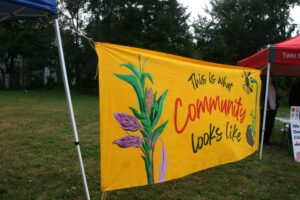 BY STEPHANIE FOX
BY STEPHANIE FOX
The South Minneapolis neighborhood of East Phillips held its annual Harvest Moon Block Party on Sept. 21, an annual event where local community and civic organizations come together to give residents information on what is happening in their area, from local problems to possible solutions. Some groups presented volunteer opportunities and others came to show their cultural traditions through music, dance and food. The neighborhood is diverse, with more than 50 percent of the population Black or Hispanic. East Phillips also includes the American Indian Little Earth residential community. The neighborhood has had difficulties for decades, but the event is a way for the community to find ways to solve problems.
Youth Journalism
Activist Christian Flores is just 14-years old but, as part of the Youth Community News team, he said he hopes to get involved in ways to help his community in East Phillips. People attending the event were encouraged to express themselves by creating a community hand-drawn newspaper using words and pictures. He and others at his middle school are learning how to tell the stories through print and broadcast journalism. This October they are focusing on public health, including addiction, mental health and women’s health. Youth Community Journalism Institute, at the Strong Mind Strong Body Foundation, was founded and is lead by Eric Ortiz, a journalist with 20 years experience. The organization is focused on teaching students how they can use community journalism and restorative practices to find solutions to community problems.
Opening Prayer
Members of the Bear Runners Singers opened the Harvest Moon Block Party with a traditional prayer ceremony with drums and chanting. The group was one of many artists who entertained those attending the event including Kalpulli KetzalCoatlicue Aztec Dancers, Somali Dancers and songs and poems with Jessica Carraway, Xochi De La Luna and N. Harris.
View from the Future
Local artists’ creations decorate the fence at Cedar Field Park, where community organizations have focused on improving the lives of local residents. The Harvest Moon Block Party is an annual event for the East Phillips Neighborhood.
East Phillips Neighborhood Institute
Steve Clemens, a volunteer with EPNI, is part of the neighborhood’s 10-year push for environmental justice. They have now won the right to convert a former Sears warehouse, built in 1946, to an urban farm. The city wanted to level the building and replace it with a public works facility, which would increase pollution in a neighborhood already suffering from decades of environmentally caused health problems. Those problems include asthma, lead poisoning and heart disease. But, community members protested with organized sit-ins and protests at city council chambers. The neighborhood was successful, and the Minnesota State Legislature has allocated money for EPNI’s project. The group is hoping to raise another $200,000 to complete the project. The project includes a rooftop solar array and affordable housing units. The organization is also hoping to hire a community food justice historian.
Free window fans and filters
Members of the community health team, with the support of the UMN Division of Environmental Health Services, handed out free window fans with attached air filters to help residents of East Phillips filter out toxic particles in their homes. The pollution includes outdoor air pollution, indoor pollution from gas stoves and infectious diseases such as Covid. The team said that they distributed nearly 100 of these units. East Phillips has a history and continues to have problems caused by decades of pollution from three nearby highways and industries including an asphalt plant, a metal foundry and a roofing company.
Hydroponics at Blue Water Farms
Plans are underway for Blue Water Farms, a food production system that combines aquaculture and hydroponics. The indoor farm will combine fish tanks and plants growing in a water-based nutrient provided by the fish and once in production, would provide vegetables and fish for sale. Thad Erickson was there to explain the system. At the indoor farm fish tanks, a raceway system was built to copy a running stream and would grow healthy fish (they hope to raise walleye). The fish would be fed mealworms, “then would eat, grow and poop,” said Erickson, creating a high nutrient environment to grow plants beginning with micro greens and camelina, a grain crop that can be eaten by people or sold to backyard chicken farms. The fish would be sold to the community, including schools and hospitals. “This would be an industry first”, said Erickson. He hopes the farm would be up and operating within 16 to 24 months.






















